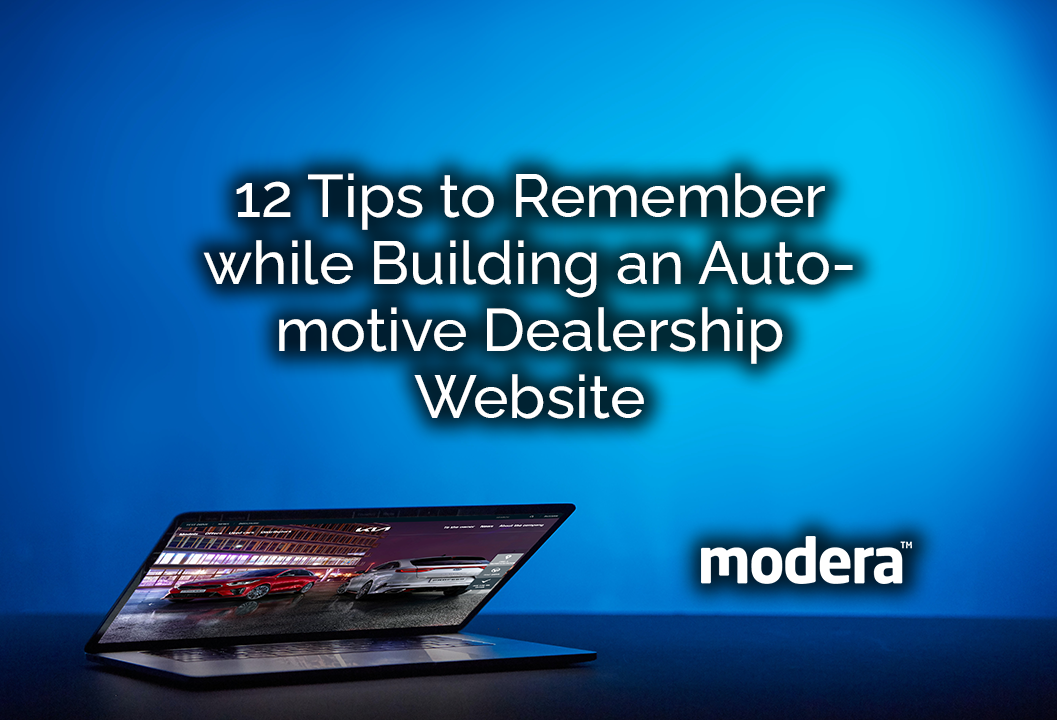
Digital connectivity has got a great boost thanks to the Covid-19 pandemic, when the entire world transitioned to conducting business online. A few years back, users would simply research cars online or start the buying process by visiting a dealership website. But 2020 changed completely changed the game! Consumers now began to actively scout for options so they could complete the entire purchase of a vehicle online. It includes selecting a car, checking out features, opting for virtual test drives, completing the paperwork, and getting the vehicle delivered to their doorstep. That is why you need a bespoke automotive dealership website for your business!
Developing a car dealership website – starting from scratch
To make your automotive dealership website really stand out from your competitor websites you need to give customer a better experience. Here are a few aspects to keep in mind before you start working on an automotive dealership website:
Admin Panel
Admin panel is where you can modify and change user details, accounts, and other sections of the website. Update information about products or create listings – the admin panel lets you manage the entire website from your dashboard.
UI Design
To develop a car dealing website, you need a stylish automotive UI. A clean and simple interface is a must, so users can navigate quickly and easily. Fancy websites that look good but are cluttered with information won’t be of much use.
Quality Content
Prospective buyers will definitely research the vehicle online before buying. The website should be informative with rich and useful content. It has to be one-stop solution to purchasing problems. Ensure that users don’t have to go anywhere else to learn about a particular make or model. Provide adequate information about the purchase process, financing options, etc. High-resolution images and videos are necessary as well.
12 tips for building an automotive dealership website:
1. Responsive design
Most customers these days access dealership websites through their mobile phones, just like ecommerce websites. To create a positive impression in their minds, you must offer seamless mobile navigation. You can’t afford to lose out on customers due to a slow website or cluttered content. The website should be able to function properly across all mediums, be it smartphones, and tablets, or PCs and laptops. When someone visits the dealership website, they don’t want to spend time figuring out where the information is available. A simple yet eye-catching website is required – remember these:
- Customers should be able to quickly scan through the website and find what they want. It drives more traffic this way!
- A well-segmented and comfortable-to-read home page guarantees a better user experience. An aesthetically appealing theme with formatted visual content is a must.
- Customers are able to look at call to action (CTA) buttons more clearly, which generates more leads and conversions.
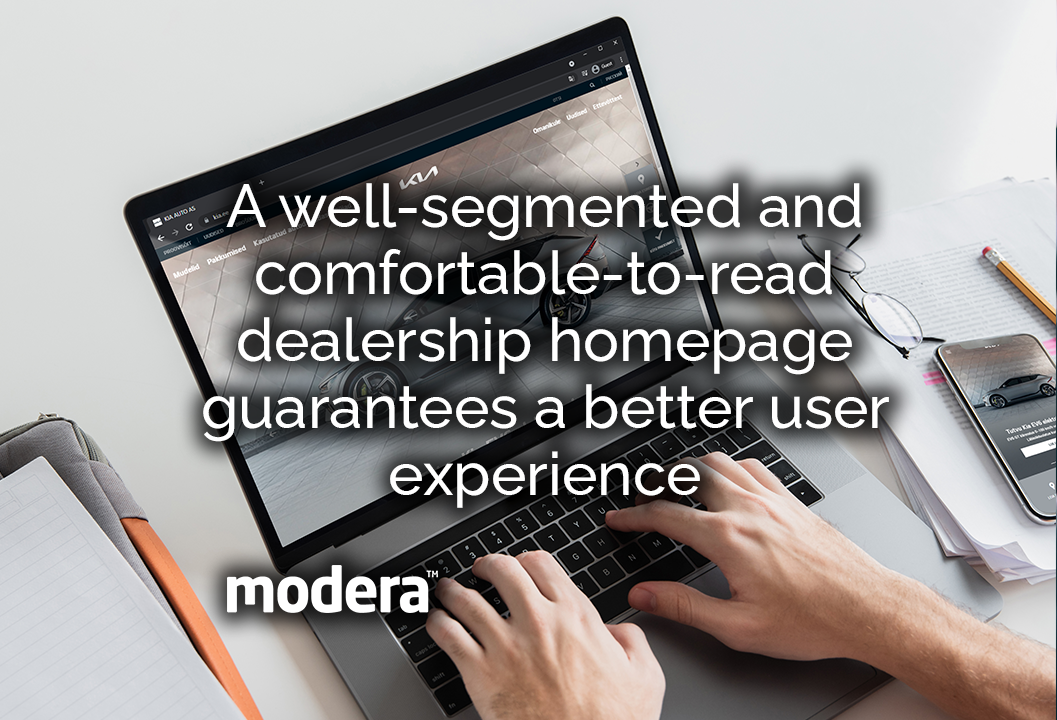
Moreover, if your website isn’t responsive, it is less likely to appear in Google’s search engine results. More than 60% of automobile searches are initiated from Google. Needless to say, the search engine favors the site that is more responsive. Accelerated Mobile Pages (AMP) – it is an all-new framework that guarantees the best possible user experience for mobile users. AMP is designed in a way to support mobile-friendly pages. You can offer fast-loading mobile-friendly pages to users, and get rewarded with minimum bounce rates.
2. An accessible database
Every dealership needs to maintain an automotive database that can be tweaked, updated, and modified, as and when required. Databases should store in-depth and relevant information about vehicles, sales, customers, and so on. Their accessibility is defined by privileges and permissions. View and edit permissions to users are granted by an admin. Databases can be exported easily as well.
3. Multiple users and access level system
Several users such as dealers, customers, sales personnel, and admin should be able to manage data smoothly. They should also be able to access information right away with the aid of multiple users and access level systems. For instance, an admin can access, edit, or change data, while sales teams can control pricing and listings. A multi-user and access level system makes operations of car dealing websites seamless.
4. CRM solution for sales management & multi-lingual flexibility
Managing sales of a dealership is anything but easy, which means you require a robust CRM solution. Effective CRMs should integrate seamlessly with 3rd party CRM solutions, depending on client requirements. Automotive dealership websites should have complete multilingual flexibility too, along with support for regional or international consumers. The website design is also defined based upon the unique circumstances surrounding your organization, and business requirements.
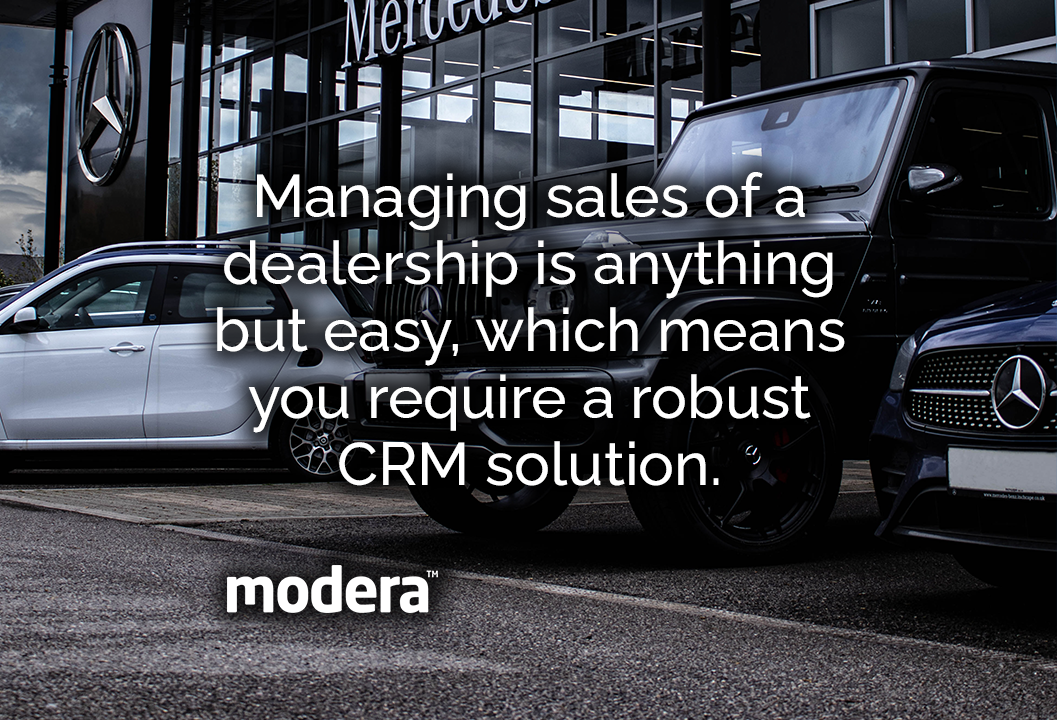
5. Smart searching
When people visit your website, they want to look up relevant information quickly. This is where “smart search and filtering” plays an integral role. With just a few clicks, users will get access to the info they want. Smart search functionalities and powerful filters deliver exact and comprehensive results based on end user requirements. Interactive tools need to be featured on the site for changing the search criteria. Users should be able to filter searches by adjusting price, vehicle make, model category, etc. It makes processes hassle-free, and gives you a definite competitive edge.
6. Landing page optimization
Designing landing pages is the easy part! But if they lack significant aspects to get website traffic, the entire effort goes down the drain. A common mistake is using wrong meta tags and titles. For instance, if your dealership sells Toyota cars, the meta title can’t be solely focused on Toyota. It needs to include “used Toyota vehicles” too and if you sell in a certain vicinity, the location has to be mentioned. The title will say “used Toyotas in New York”. The landing pages can be further optimized by segregating them into different categories. Utilize terms like “used cars”, “new vehicles”, “old cars”, “vintage cars”, and so on. Categories should include relevant CTA buttons – they need to be prominent enough to attract customer’s attention.
7. Enquiry forms about vehicles
If a user likes a particular car, they should be able to get in touch with a specialized salesperson right away. While calling is also an option, it is more feasible to first get the possible details of the car itself. That is why you need a vehicle inquiry form. Direct customers to fill it out – it can be a preemptive approach, so they can save time while visiting the facility.
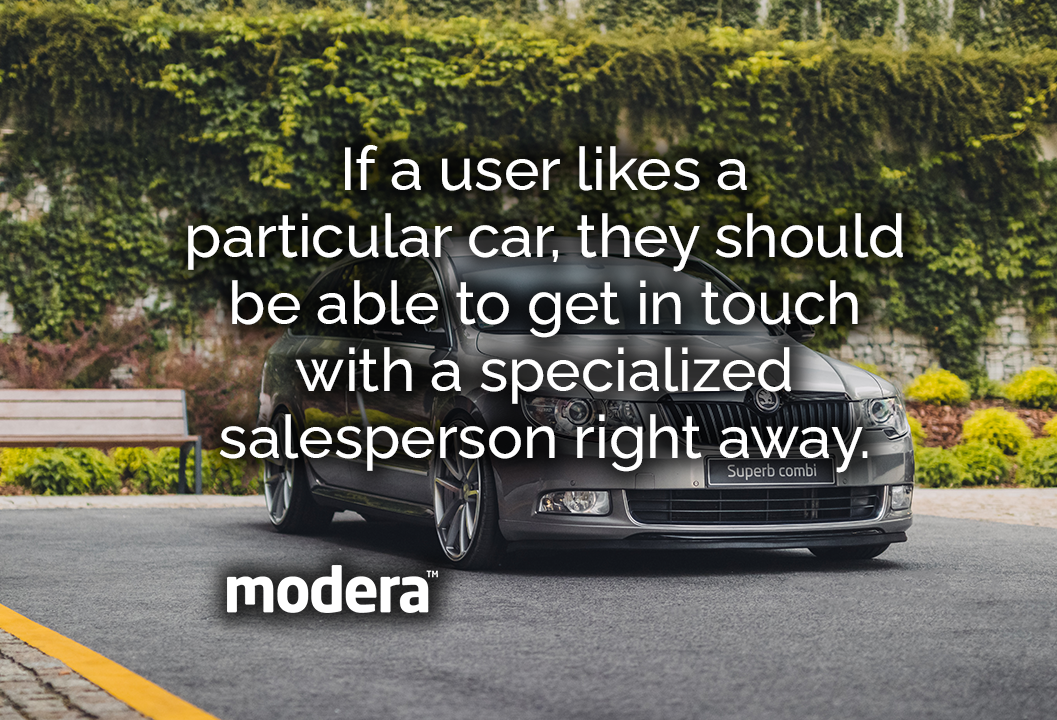
8. SEO (Search Engine Optimization)
Search engine optimization or SEO is very important if you want to ensure that people know more about your business and thus your sales increase. The usage of SEO will ensure that your dealership website appears among the first few listings of a search engine. This way you get more traffic. Needless to say, the more hits you get, the more people know about your products, which increase the conversion rate. This is where keyword research and analysis come into play. While you might have interesting content, successful online marketing is when users enter queries via keywords into the search engine and your website pops up on their screens. You need to utilize those words (meta tags and meta titles) that the audience is actively looking for and generate desired results.
9. FAQ Section
Customers will have loads of questions when they visit your website. That is why you need an FAQ section with useful content. A lot of dealerships don’t pay much attention to FAQs while building their website. But that is a huge mistake, because users come equipped with several questions and seek direct answers. When they get a satisfactory and clear answer from the FAQ section, it helps them with purchase decisions. This way, it boosts sales – FAQs play a crucial role in converting leads to paying customers. Contents of the FAQ are also indexed in search engines and help in SEO. Apart from adding quality content, this page should feature an interactive and eye-catching design as well. The objective is to pique the interest of users from the get-go.
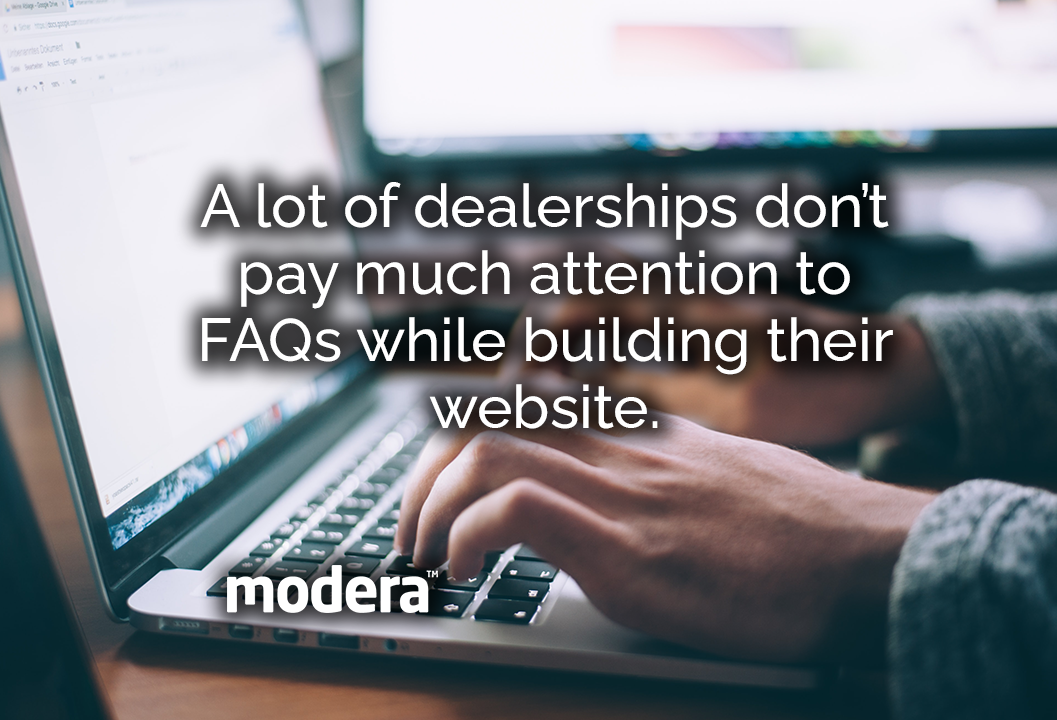
10. Stunning Visuals
If you don’t show your customers what their desired car looks like, how will they get convinced? Without a visual presentation, a buyer will move off to a rival website. Thanks to an evolving marketplace and new technologies, you can upload high-definition, premium quality images and videos of the car interiors, the exterior captured from multiple angles, what features are available, virtual test drives (important in post Covid era) etc. Let the customer get a feel of what it would be to own the car!
11. Car Compare & Wishlist
Users should be able to compare specifications of multiple easily, while checking out snapshots and videos. This makes purchase decisions easy, and also prevents users from moving off to other websites to get information. Wishlist functions allow buyers to keep tabs on their preferred car listings. They can create profiles or charts of their desired vehicles. Every time a similar car is listed or one of their favorites is available, they receive a notification. Not only that, but a quality designed wishlist function can track the data. It can be used to easily identify trends and later respond with offers related to their products via custom notifications.
12. Smart AI chatbots
Using Artificial Intelligence technology, smart chatbots can be created to provide exclusive solutions related to sales, booking and customer support. It can answer questions related to inventory and pricing, or resolve complaints. Smart chatbots can be programmed for booking purposes as well. This feature makes the website more interactive, which helps with customer retention, lead capture and analytics.
Why choose Modera Webfront for designing automotive dealership websites?
Modera is a cloud-based industry specific website building system. It is designed based on the requirements and processes of the automotive industry. As of now, it is one of the most advanced content management systems when it comes to automotive websites.
If you don’t have a solid online presence, no one will recognize your business. Being online basically “puts you on the digital map”. It is definitely worth your while to establish an online profile via a robust, innovative, and aesthetically pleasing automotive dealership website. A website that looks haphazard and is missing the right elements and tools won’t make the cut.
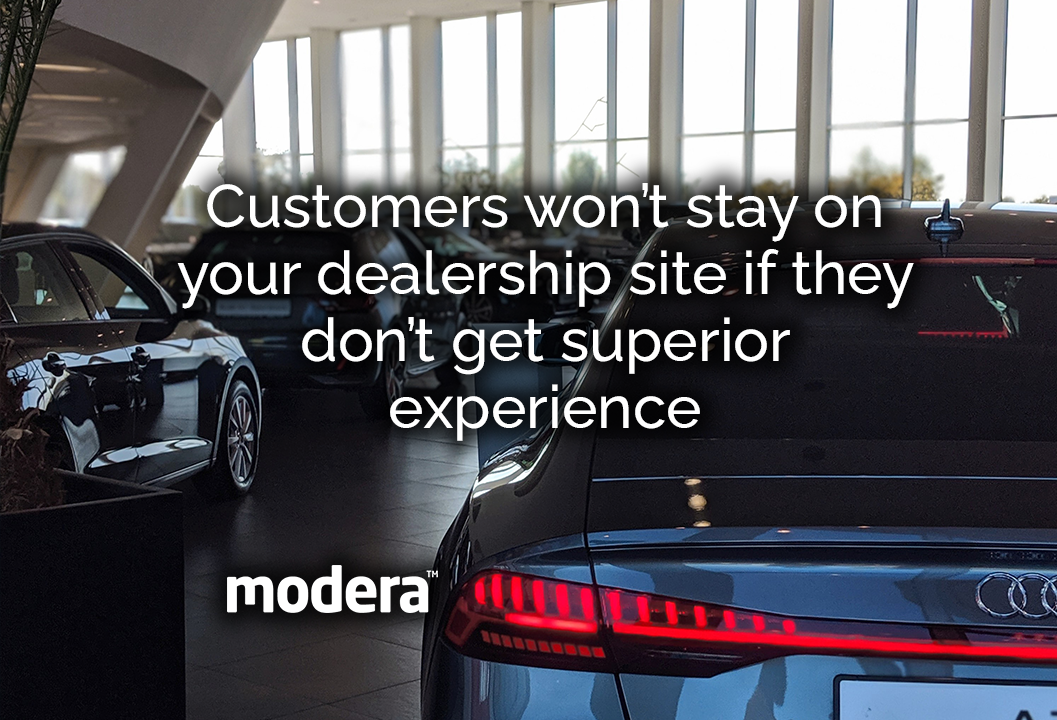
Customers won’t stay if they don’t get superior experience. Moreover, you only have one chance to get it right. Potential buyers visit your website – if they like what they see, they will stay, or else they leave. That is why the website requires the necessary structure and elements that make sense. The automotive dealership website should cater to a wide range of tastes and preferences, and make the purchase process convenient. The Modera Webfront solution offers that and more:
- On-site editing – A seamless on-site editing interface offers a smooth way to work with the content and other aspects of websites. Editors can modify content in pages directly while viewing the website live from a dashboard.
- Car configurator with finance calculator – Invite clients to visualize what their dream car looks like! Let them design and build their next car, while helping with budgeting at the same time.
- Car comparison module – Compare and contrast multiple vehicles, so customers can zero in on the one that best suits their requirements.
- New cars showroom – What if clients can’t visit the showroom in-person? There is no reason for them to miss out on that experience. This is a special page that presents preferred vehicles to the finest details. They can look up specifications, research available options, check visuals, and scout prices.
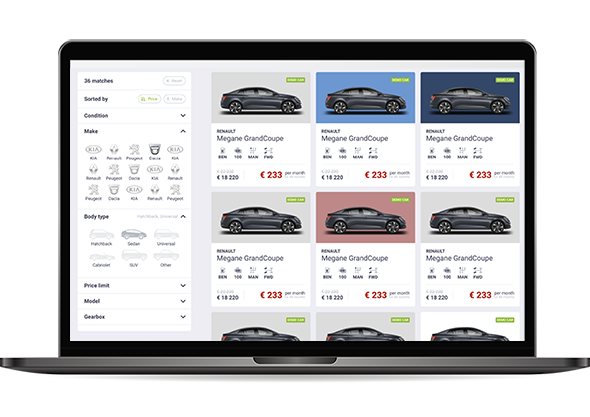
- Accessories sales module – If your customers are looking for specific accessories, don’t disappoint them. This tool lets visitors search accessories for their vehicle and place orders accordingly.
- New and used cars listings – Feel free to publish your inventory and update when required. It helps users find their next vehicle, so they can begin the purchase process.
- Trade-in module “Value my car” – Clients need to know what their car is worth before going in for the trade-in. This tool provides a fair evaluation and generates excellent leads.
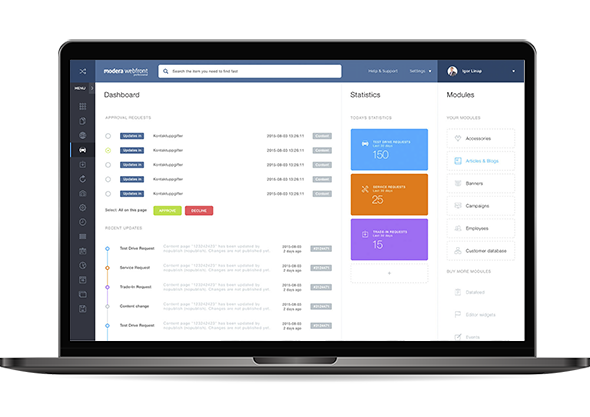
- Offers, campaigns and banners management – Your website needs to be promoted and advertised in the right platforms. You can create and manage banners, ads, special offers, campaigns, and other promotional material.
- News & events management – Keep clients updated about the latest goings-on in your dealership. Publish news, videos, brochures and manuals on the site.
- Service booking form – Offer customers the ease of scheduling maintenance and repairs via a comprehensive online booking form.
- Test drive booking form – To prevent crowding in your facility, allot slots to clients, so they can experience hassle-free test drives.
- Custom forms builder – Lead generation is a constant process. Use this custom form to get more leads consistently.
- Company location & contacts management – Control and supervise company data such as locations, departments, and employee contacts and images, from a centralized hub.
- SEO management – Ensure your website is optimized and ranking well on search engines, with the proper SEO tools.
A customized automotive dealership is a must if you wish to stay ahead of the competition in the post-pandemic era. To put it in a nutshell, it ensures you get more leads, makes the purchase process seamless for customers, and provides an amazing experience for them.
If you want to make your automotive website as professional as possible, then request a demo here.
